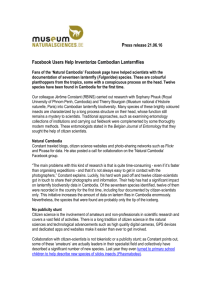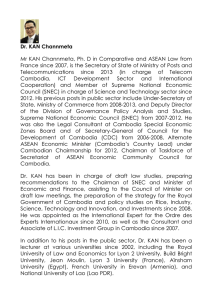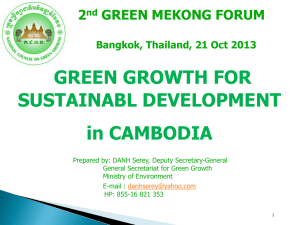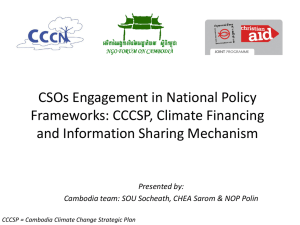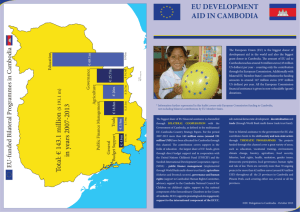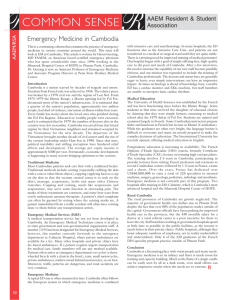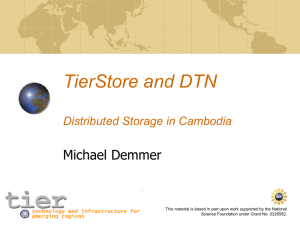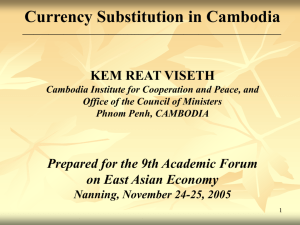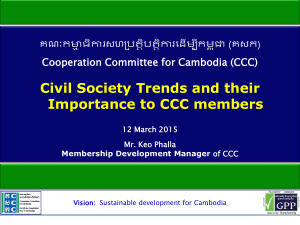Cambodia - Youthpolicy.org
advertisement
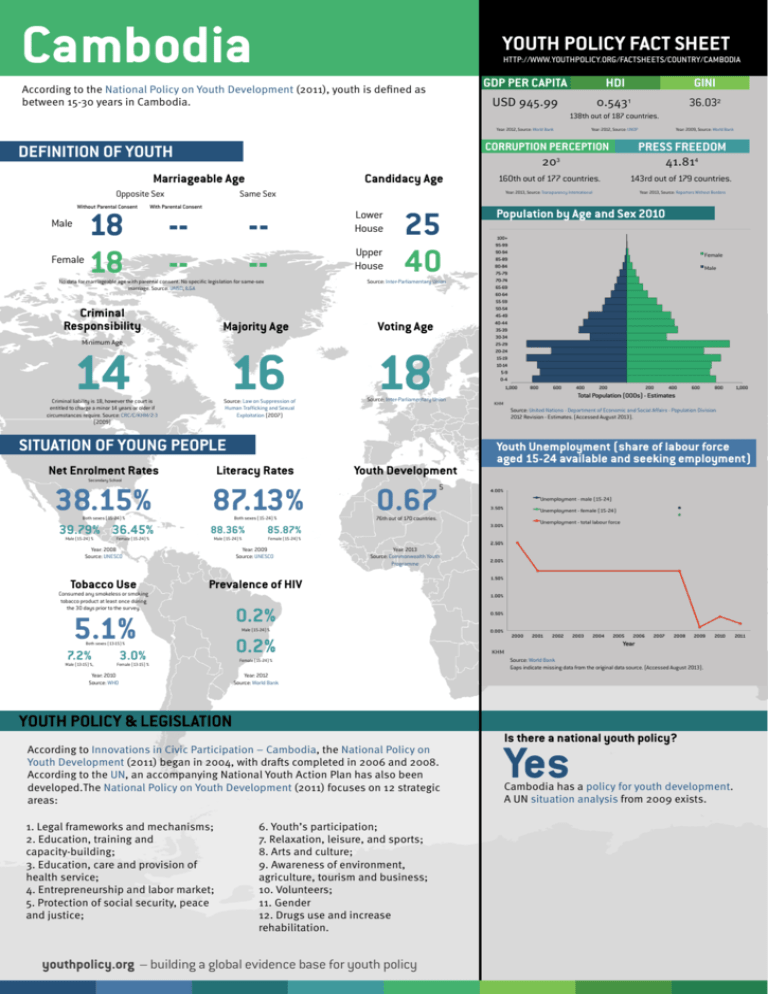
Cambodia YOUTH POLICY FACT SHEET HTTP://WWW.YOUTHPOLICY.ORG/FACTSHEETS/COUNTRY/CAMBODIA According to the National Policy on Youth Development (2011), youth is defined as between 15-30 years in Cambodia. ^GDP PER CAPITA HDI USD 945.99 0.543 GINI 36.032 1 138th out of 187 countries. Year: 2012, Source: World Bank DEFINITION OF YOUTH Marriageable Age Without Parental Consent Male Female 18 18 Candidacy Age Same Sex Opposite Sex With Parental Consent --- --- No data for marriageable age with parental consent. No specific legislation for same-sex marriage. Source: UNSD, ILGA Criminal Responsibility Majority Age Minimum Age 14 16 Criminal liability is 18, however the court is entitled to charge a minor 14 years or older if circumstances require. Source: CRC/C/KHM/2-3 (2009) Source: Law on Suppression of Human Trafficking and Sexual Exploitation (2007) Lower House Upper House 25 40 Secondary School 38.15% Both sexes (15-24) % 39.79% 36.45% Male (15-24) % Female (15-24) % Female (15-24) % Year: 2008 Source: UNESCO Year: 2009 Source: UNESCO Tobacco Use Prevalence of HIV 5.1% 0.2% 0.2% Consumed any smokeless or smoking tobacco product at least once during the 30 days prior to the survey. Both sexes (13-15) % 7.2% Male (13-15) %, 3.0% Female (13-15) % Year: 2010 Source: WHO Population by Age and Sex 2010 Source: United Nations - Department of Economic and Social Affairs - Population Division 2012 Revision - Estimates. (Accessed August 2013). Youth Unemployment (share of labour force aged 15-24 available and seeking employment) 5 76th out of 170 countries. Year: 2013 Source: Commonwealth Youth Programme Male (15-24) % Female (15-24) % Source: World Bank Gaps indicate missing data from the original data source. (Accessed August 2013). Year: 2012 Source: World Bank YOUTH POLICY & LEGISLATION According to Innovations in Civic Participation – Cambodia, the National Policy on Youth Development (2011) began in 2004, with drafts completed in 2006 and 2008. According to the UN, an accompanying National Youth Action Plan has also been developed.The National Policy on Youth Development (2011) focuses on 12 strategic areas: 1. Legal frameworks and mechanisms; 2. Education, training and capacity-building; 3. Education, care and provision of health service; 4. Entrepreneurship and labor market; 5. Protection of social security, peace and justice; Year: 2013, Source: Reporters Without Borders 18 0.67 85.87% 143rd out of 179 countries. Source: Inter-Parliamentary Union 87.13% Male (15-24) % 160th out of 177 countries. 41.814 Voting Age Youth Development 88.36% PRESS FREEDOM Source: Inter-Parliamentary Union Literacy Rates Both sexes (15-24) % Year: 2009, Source: World Bank CORRUPTION PERCEPTION 203 Year: 2013, Source: Transparency International SITUATION OF YOUNG PEOPLE Net Enrolment Rates Year: 2012, Source: UNDP 6. Youth’s participation; 7. Relaxation, leisure, and sports; 8. Arts and culture; 9. Awareness of environment, agriculture, tourism and business; 10. Volunteers; 11. Gender 12. Drugs use and increase rehabilitation. youthpolicy.org – building a global evidence base for youth policy Is there a national youth policy? Yes Cambodia has a policy for youth development. A UN situation analysis from 2009 exists. Cambodia YOUTH POLICY FACT SHEET HTTP://WWW.YOUTHPOLICY.ORG/FACTSHEETS/COUNTRY/CAMBODIA YOUTH & PUBLIC INSTITUTIONS The Youth Department within the Ministry of Education, Youth & Sports (MoEYS) has responsibility for youth affairs and the development of the National Policy on Youth Development (2011).The National Council for Youth Development is responsible for “coordinating, monitoring, evaluating and assisting the government in the process of developing youth.” According to The Phnom Penh Post in August 2011, the Council will “promot[e] the youth programme into national budgeting, within various line ministries, public institutions and local authorities.” Is there a governmental authority (ministry, department or office) that is primarily responsible for youth? Yes YOUTH & REPRESENTATION The Youth Council of Cambodia is an independent, apolitical organisation “formed as a coalition of five major student and youth organizations”. It was established to “advocate for peaceful democratic reform and promote voter and civic education among Cambodian youth and students.” Its mission is to “foster a greater participation of youth in development and provide a voice for young Cambodians” and through trainings and programmes has become “a voice for students advocating non-violent democratic change in Cambodia.” Does the country have national and/or regional youth council(s)? Yes YOUTH BUDGET & SPENDING The Global Post reports that the 2014 Cambodia budget included KHR 1.337 million (USD 335 million) on education. The full Budget Law 2013 (2012) is available in Khmer. According to the World Bank, Cambodia spent 12.39% of its government expenditure on education provision in 2007, and 2.60% of its GDP in 2010. Total Expenditure on Education as a Percentage of Government Spending and GDP What is the budget allocated to the governmental authority (ministry, department or office) that is primarily responsible for youth? Unknown Publications & Reviews Visit our library for further reading: http://www.youthpolicy.org/library/cambodia Footnotes 1) A Human Development Index (HDI) value of zero means low human development, and a value of 1 means very high human development. HDI is a composite index measuring three dimensions: a long and healthy life, knowledge and a decent standard of living. (UNDP) 2) An Income Gini coefficient of zero means absolute equality, and a coefficient of 100 means absolute inequality. Note: figures multiplied by 100 for OECD data. (World Bank/OECD) 3) A Corruption Perception Index (CPI) value of zero means that a country is perceived as highly corrupt, and a value of 100 means it is perceived as very clean. (Transparency International) 4) A Press Freedom Index (PFI) value of zero means the highest degree of freedom that journalists, news organisations and netizens enjoy, and a value of 100 means the lowest. (Reporters Without Borders) Source: World Bank Gaps indicate missing data from the original data source. (Accessed August 2013). youthpolicy.org – building a global evidence base for youth policy 5) A Youth Development Index (YDI) value of zero means little or absolutely no youth development, and a value of 1 means the highest possible level of youth development attainable. YDI is a composite index measuring five domains: education, health, employment, political, and civic participation. (Commonwealth Youth Programme) For full citation list & more information, visit: http://www.youthpolicy.org/factsheets/country/cambodia Last Updated: 05 FEBRUARY 2014
